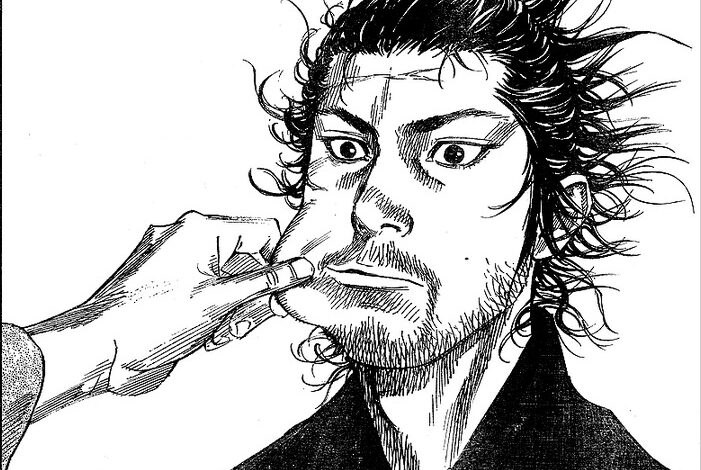Vagabond Manga: The Definitive Guide to Takehiko Inoue’s Samurai Epic

Introduction
Vagabond is a manga that has transcended its genre, captivating readers with its intricate storytelling and stunning artwork. Created by Takehiko Inoue, Vagabond follows the life of Musashi Miyamoto, a historical figure renowned as one of Japan’s greatest swordsmen. The manga adapts Eiji Yoshikawa’s novel Musashi, bringing the tale of the legendary warrior to life through Inoue’s unparalleled artistic vision. However, Vagabond is much more than a simple story of swordsmanship—it’s a deep exploration of human nature, honor, and the quest for personal growth.
Since its release, Vagabond has garnered both critical and popular acclaim, earning a place among the best manga ever created. The series has become an iconic depiction of the samurai ethos, combining historical context with philosophical reflections on life, death, and invincibility. In this guide, we will explore the origins, characters, themes, and artistic mastery that make Vagabond a masterpiece, as well as its impact on modern culture.
1. Origins and Background of Vagabond Manga
1.1 The Inspiration Behind Vagabond
Takehiko Inoue, already known for his groundbreaking basketball manga Slam Dunk, ventured into a completely different world with Vagabond. Inspired by Eiji Yoshikawa’s novel Musashi, Inoue reimagined the legendary figure of Musashi Miyamoto, a warrior whose name has become synonymous with the art of swordsmanship. The novel provides the foundation for Inoue’s adaptation, but Vagabond takes it further by delving into the psychological and spiritual journey of its characters.
Set in the early Edo period, Vagabond places Musashi’s journey against the backdrop of post-war Japan. This setting not only allows Inoue to explore historical themes but also gives readers a glimpse into the hardships and conflicts that shaped Japan’s warrior class. Through this lens, Inoue brings Musashi’s story to life, emphasizing the universal themes of survival, self-discovery, and the search for meaning.
1.2 Takehiko Inoue’s Artistic Vision
Inoue’s art is one of the most defining aspects of Vagabond. Known for his meticulous attention to detail, Inoue uses traditional Japanese aesthetics to elevate the visual storytelling. His artwork is not just about showcasing action; it captures the essence of emotions, nature, and the inner turmoil of the characters. Inoue’s brush techniques and ink drawings are reminiscent of classical Japanese paintings, blending realism with expressive, almost poetic depictions of the characters’ journeys.
The artist’s ability to convey silence and introspection is one of his greatest strengths. Battles are not just physical confrontations; they are symbolic moments where characters confront their deepest fears and desires. Inoue’s skill in capturing these moments sets Vagabond apart from other action-oriented manga.
1.3 Serialization and Reception
Vagabond first began serialization in 1998 in Morning magazine and quickly gained a dedicated following. Over time, the series has won numerous awards, including the prestigious Tezuka Osamu Cultural Prize, solidifying its status as a critically acclaimed masterpiece. Internationally, Vagabond has been praised for its unique combination of historical narrative and philosophical depth. However, the series went on an indefinite hiatus in 2015, leaving fans awaiting its conclusion. Despite this, Vagabond’s unfinished status has not diminished its impact on readers and the manga industry.
2. Plot and Character Analysis
2.1 The Journey of Musashi Miyamoto
At the heart of Vagabond is the character of Musashi Miyamoto, a man who transforms from a violent and directionless youth into a philosophical warrior. Musashi’s journey is one of self-discovery, where he grapples with his violent tendencies and seeks to understand the meaning of true strength. In the early stages of the story, Musashi is driven by his desire to become “invincible under the heavens.” This ambition leads him through numerous battles, where he learns not only the art of swordsmanship but also the value of restraint and discipline.
As the story progresses, Musashi’s character evolves. He begins to question the purpose of his battles and the meaning of life itself. This transformation is gradual and filled with moments of doubt, reflection, and philosophical musings. Musashi’s internal conflict between his warrior’s path and the search for inner peace is one of the most compelling aspects of the manga.
2.2 Key Supporting Characters
Alongside Musashi, several key characters play pivotal roles in shaping the story. Matahachi Honiden, Musashi’s childhood friend, serves as a foil to Musashi’s character. Whereas Musashi seeks personal growth and enlightenment, Matahachi remains trapped in his vices and indecision. Their contrasting paths highlight the different ways individuals deal with the hardships of life.
Otsu, a woman both Musashi and Matahachi care for, represents the emotional and romantic dimension of the story. Her interactions with Musashi reveal a softer side to his character, as he struggles to reconcile his feelings with his warrior’s code. Sasaki Kojiro, Musashi’s destined rival, also plays a crucial role in the narrative, embodying an opposing philosophy of combat and life. Their eventual duel becomes a central point of tension in the story.
3. Themes and Philosophies in Vagabond
3.1 The Samurai Code and Bushido
One of the primary themes of Vagabond is the samurai code, or Bushido, which emphasizes honor, loyalty, and discipline. Musashi’s journey reflects his struggle to adhere to these values while confronting the violent realities of his time. The concept of “invincibility” that drives Musashi is rooted in the samurai’s pursuit of mastery, not just of combat, but of the self.
Through Musashi, Inoue explores the contrast between physical strength and inner peace. Musashi’s ultimate goal is not merely to become the greatest swordsman, but to find a deeper sense of purpose in life. His battles, therefore, are not just about defeating enemies but about overcoming his own inner conflicts.
3.2 Nature, Isolation, and Self-Reflection
Nature plays a significant role in Vagabond, often reflecting the internal states of the characters. As Musashi wanders through the wilderness, he experiences long periods of isolation that force him to confront his own fears, doubts, and desires. The landscapes in Vagabond are more than just settings—they are symbolic representations of Musashi’s emotional and philosophical journey.
In these moments of solitude, Musashi engages in deep self-reflection, questioning the meaning of life, death, and strength. This introspective journey is one of the most profound aspects of the manga, offering readers a glimpse into the mind of a man who is constantly evolving.
4. The Legacy and Impact of Vagabond Manga
4.1 Influence on Manga and Pop Culture
Vagabond has had a lasting influence on both manga and pop culture. Inoue’s unique storytelling and art style have inspired a new generation of manga artists, who seek to combine action with philosophical depth. The series’ emphasis on self-discovery and personal growth has resonated with readers worldwide, making Vagabond a benchmark for quality in the manga industry.
4.2 Cultural Significance of Vagabond
Beyond its artistic influence, Vagabond has contributed to the global fascination with samurai culture. Through Musashi’s journey, readers are introduced to the complexities of the samurai ethos and the historical context of post-war Japan. The series’ blend of historical accuracy and creative storytelling has made it a cultural touchstone, influencing not just manga, but also films, games, and literature that explore the samurai spirit.
Conclusion
vagabond manga is a remarkable fusion of art, history, and philosophy. Takehiko Inoue’s depiction of Musashi Miyamoto’s journey is not just a story of a swordsman seeking invincibility, but a profound exploration of human nature and the quest for meaning in life. Despite its unfinished status, Vagabond remains one of the most influential works in manga history, inspiring readers to reflect on their own paths and the nature of true strength.




